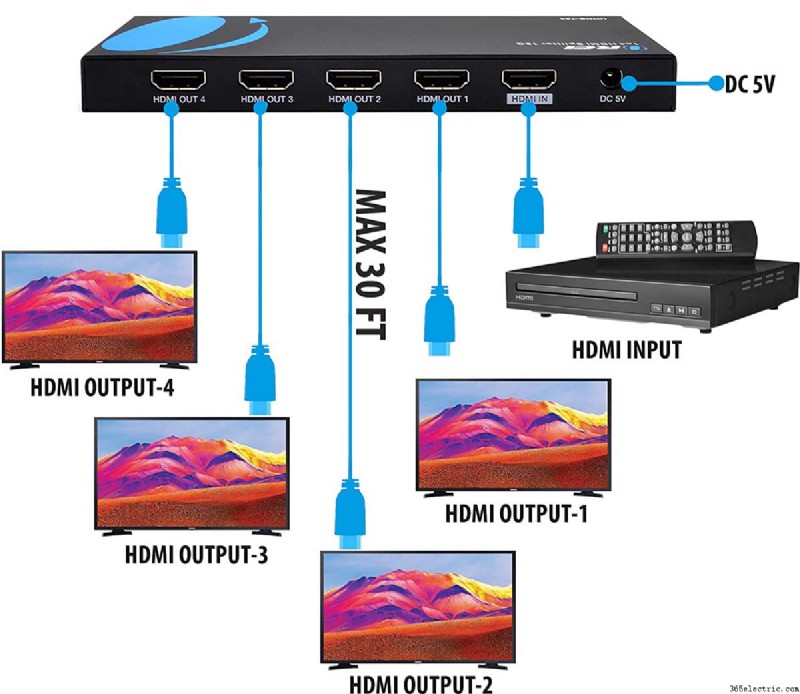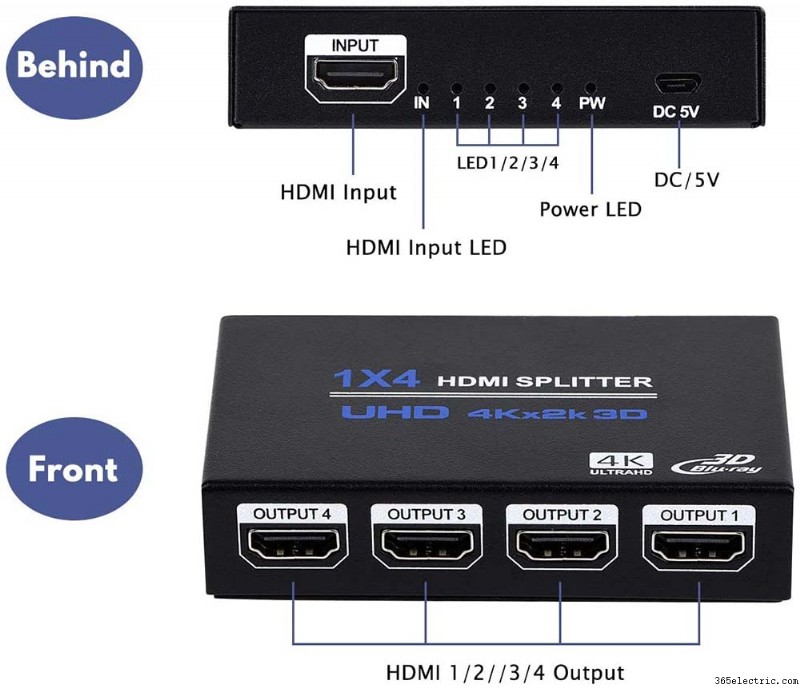Come collegare più monitor al tuo sistema di telecamere di sicurezza
È una domanda comune:come collegare più monitor a un sistema di telecamere di sicurezza? Molto spesso è necessario visualizzare le telecamere su vari monitor. Diciamo un monitor nell'home office, un altro nel soggiorno, un altro nel seminterrato, ecc.
La maggior parte dei DVR o NVR sono dotati di uscita sia HDMI che VGA. Alcuni di questi possono essere utilizzati contemporaneamente, ma la maggior parte di essi è progettata per essere utilizzata l'una con l'altra. Se desideri utilizzare solo due monitor, puoi collegarli utilizzando l'uscita HDMI e VGA per ciascuno di essi.
Il modo più efficace per visualizzare le telecamere su più monitor è utilizzare uno splitter HDMI (o uno splitter VGA se il registratore è una delle versioni precedenti). Ti consigliamo di utilizzare uno splitter-amplificatore che garantisca la piena potenza del segnale a tutti i monitor senza compromettere la qualità dell'immagine.
Solitamente questi tipi di splitter sono alimentati, mentre gli altri tipi sono detti passivi (non alimentati) che degradano la qualità dell'immagine.
In questo articolo, mostreremo come visualizzare le telecamere di sicurezza DVR o NVR su più monitor o TV contemporaneamente. Il metodo mostrato qui è conveniente e facilmente implementabile.
Nota: Le istruzioni mostrate qui sono applicabili se stai usando uno splitter HDMI o uno splitter VGA, stessa logica e passaggi.
Come collegare più monitor al tuo sistema di telecamere di sicurezza
Parliamo un po' dei vantaggi dell'utilizzo di più monitor nei sistemi di telecamere di sicurezza. È possibile collegare 2, 4, 8 o anche più monitor per visualizzare contemporaneamente il feed live delle telecamere. Ciò aumenta il livello di monitoraggio poiché puoi visualizzare le telecamere anche in aree in cui non c'è Internet.
Nelle installazioni commerciali, è possibile utilizzare più monitor per monitorare meglio il processo di produzione, la spedizione, il trasporto merci e la banchina di carico, il reparto vendite, ecc. Le possibilità sono infinite.
Nelle applicazioni residenziali, puoi controllare le telecamere senza abitare in camera da letto o in soggiorno. Ad esempio, puoi avere un monitor in soggiorno, uno nell'ingresso, uno nel seminterrato, uno in soggiorno, ecc.
Il processo è facile e conveniente. Poiché la maggior parte dei DVR o NVR CCTV ha un'uscita HDMI, utilizzeremo uno splitter HDMI in questo esempio. Ma il processo è lo stesso anche per le uscite VGA e CVBS. We’d recommend using the HDMI cable since the image quality will be superior and the connection actually supports audio. For VGA, it will be just the live image, without any audio transmission (if your system has any mics installed in it).
Below you can see diagrams that outline the connection configurations for hooking up multiple monitors. For example, let’s check a 4 port HDMI splitter, meaning you can clone the main “HDMI signal” into four. Other splitters offer 1 to 2, 1 to 8, 1 to 16, and so on.
- To hook up four monitors using the 4 port HDMI splitter:
- Connect the DVR’s HDMI output to the input of your HDMI Splitter. The inputs should be marked “input 1”, “input 2” and so on.
- Connect the HDMI splitter output to the inputs of each monitor/TV.
- Turn on the DVR and then select the input source on each monitor. You should be able to see the camera’s feed on each monitor at the same time.

The HDMI splitter is powered on, so you need to plug the power supply into an outlet. Another thing you need to keep in mind, the quality of the image on each monitor depends on how far away the monitor is from the splitter. Additionally, the splitter must be of good quality in order to cast high-res images on the monitors. We’d recommend going for an HDMI 4K splitter.
What’s the maximum distance that an HDMI splitter works? It depends on the splitter that you’ve purchased. You need to check the spec sheet to ensure that you don’t exceed the distance. Usually, the distance can be 50 or 100 feet. The longer it runs, the higher the chances of having a flickering image.
Another trick you can use is to split the distance and place the splitter in the middle of the run. Let’s say the run is 100 feet. Set up this way:from the DVR/NVR to the splitter 40 feet, from the splitter to the monitors around 60 feet.
Also, make sure the HDMI cables are reliable. For short distances, all HDMI cables are good enough, but for longer runs such as over 50 feet, you need a high-end HDMI cable. Additionally, it may be cost-effective to use HDMI extenders over cat5e or cat6. These extenders are quite reliable and much cheaper compared to long HDMI cables. Moreover, they are thinner and easier to snake in tight spaces.

The HDMI splitter not working?
If you did everything as instructed but you still can’t see the picture on one of the monitors, check out the following tips:
- Make sure all the monitors/TVs are set to the same resolution. If one of them is 720p, set all of them to 720p.
- Make sure the HDMI splitter is getting powered on. You should see all the lights lit on the device.
Check if the distance between the splitter and the HDMI doesn’t extend to the one certified by the manufacturer. Usually, the HDMI splitter is supposed to work at 50 feet or around that. Although, it depends on the manufacturer, check out the spec sheet. - If still no picture, restart the DVR/NVR while everything is connected properly and wait for the pictures to show up on each monitor.
- If the picture is blinking or going in and out in one of the monitors, it’s possible that the distance is simply too much. Try at a shorter distance. Additionally, make sure the HDMI cable is in good condition and not damaged.
- If your runs are long, lower the resolution of the DVR/NVR and TV to the lowest one.
- Lastly, you may need to read the user guide to ensure that the devices have been connected correctly. Or you can call the seller manufacturer for technical support.
Conclusione
Hooking up multiple monitors to your security camera system is quite easy when using an HDMI splitter. These splitters can split the image into 2, 4, 8, or even 16 monitors. The image will be the same across all the monitors. If you’re looking for a new security camera system, we’d recommend checking our buying guide .
